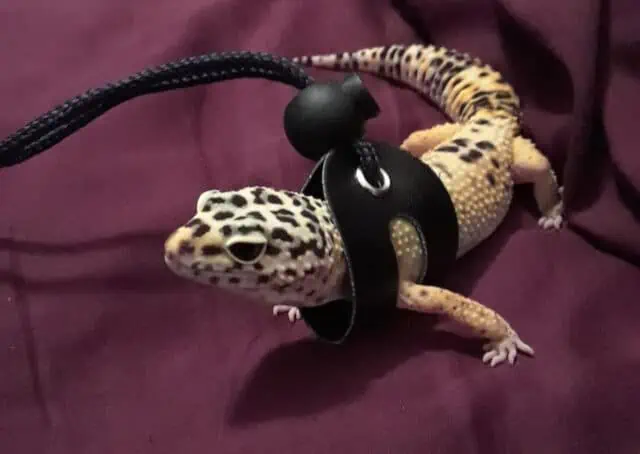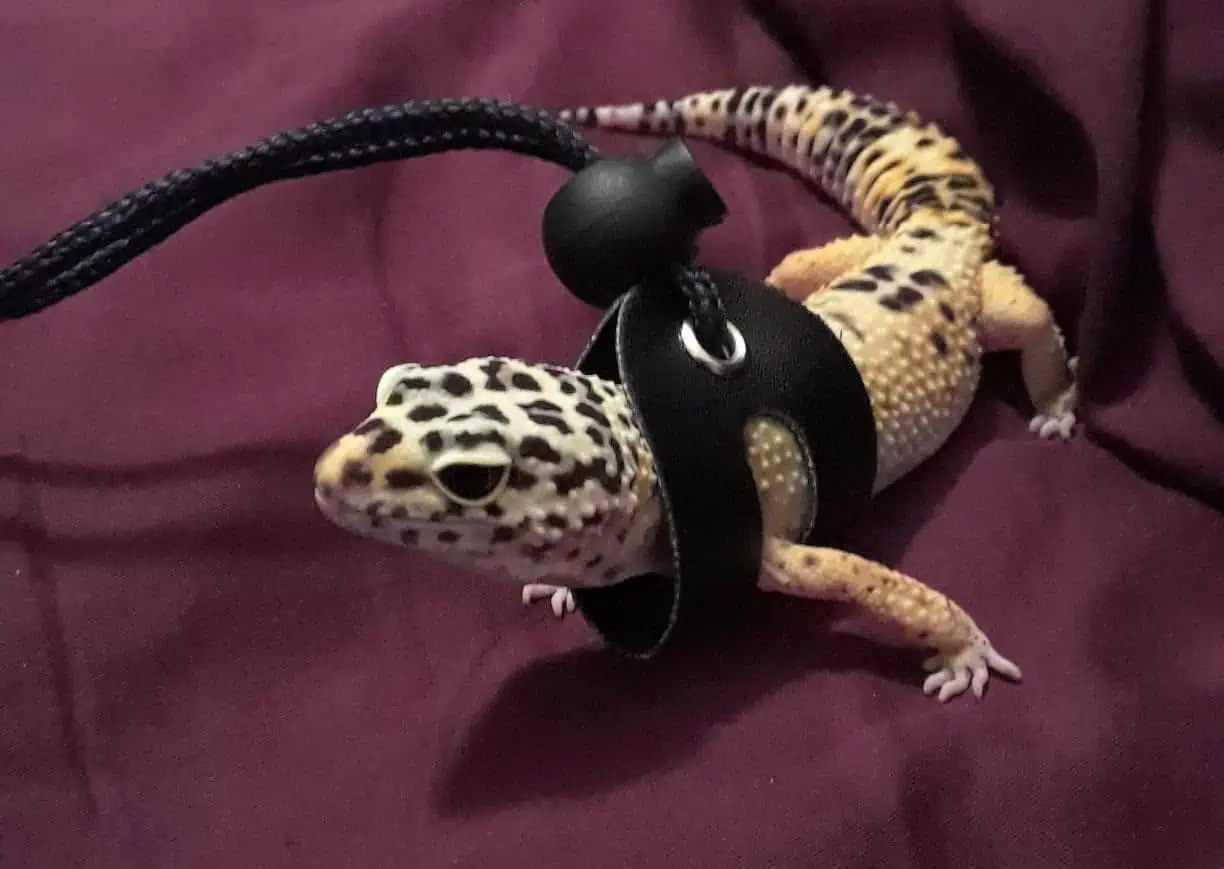Leopard gecko leash training is a practical and rewarding practice, offering a means for owners to allow their pet more freedom while maintaining safety.
Training your leopard gecko to walk on a leash can enrich their life, giving them the opportunity to explore and exercise in a controlled manner, and can also strengthen the bond between pet and owner.
Proper Equipment is Essential: Choose a harness specifically designed for leopard geckos to ensure it’s safe and fits comfortably.
Patience is Key: Gradually introduce your gecko to the harness and leash, starting with short sessions and gradually increasing the time.
Positive Reinforcement Works: Use treats and praise to reward desired behaviors and create positive associations with the harness and leash.
Safety First: Always supervise your gecko during leash training, avoiding potential hazards and ensuring a safe environment.
Bonding Enhances Training: Spend quality time with your gecko outside of training sessions to establish rapport and build trust.
Leash Training for Leopard Geckos – Is it Possible?
Leash training leopard geckos is not only possible but also quite advantageous for the geckos and their owners.
While the idea of a reptile on a leash may seem a bit unconventional, with proper training and patience, leopard geckos can be acclimated to wearing a leash, allowing them to explore and experience new environments safely.
Why Should You Train Your Leopard Gecko to Wear a Leash?

Training your leopard gecko to wear a leash is highly beneficial. It opens up a new world of exploration for leopard geckos, allowing them to experience different environments, textures, and stimuli, which is crucial for their mental well-being.
Leopard geckos, being naturally curious creatures, relish the opportunity to explore, and doing so can provide much-needed exercise and mental stimulation.
Leash training also allows for supervised outdoor exploration. This means that your leopard gecko can safely enjoy the natural sunlight, fresh air, and the richness of the outdoors without the risk of them escaping or encountering predators.
It’s a controlled way to let them experience the world, making it a fulfilling activity for them.
Getting Started With Leopard Gecko Leash Training
Embarking on leash training your leopard gecko can seem daunting, but it’s a rewarding endeavor that enhances the quality of life for your pet. This journey involves several crucial steps, beginning with preparing the right gear, introducing it properly to your gecko, and establishing a bond of trust.
Preparing the Leash and Harness
Preparing the leash and harness is the first pivotal step in leopard gecko leash training. It’s crucial to ensure that all the components are correctly assembled and adjusted to the right size to avoid any discomfort or stress to your gecko.
To begin, select a suitable harness type; a “figure-eight” harness is commonly used for its simplicity and effectiveness. The harness should be made of a soft, lightweight material to ensure your gecko’s comfort.
For harness assembly, follow the instructions provided with the harness carefully, ensuring all components are secured properly. The harness should fit snugly around your gecko’s body but should not be too tight as to constrict movement or too loose as to allow escape.
Adjusting harness size correctly is crucial; it should be snug but with enough room to fit two fingers between the harness and your gecko’s body.
Next, you will need a lightweight leash material, attached securely to the harness. Ensure there are no sharp edges or components that could harm your gecko.
Additionally, having a swivel attachment at the point where the leash connects to the harness can prevent the leash from twisting and becoming tangled.
Introducing Your Leopard Gecko to the New Gear
Introducing your leopard gecko to the new gear is a delicate process, aimed at allowing your pet to investigate and become familiar with the harness and leash.
Begin by placing the new gear within your gecko’s environment and allow them to approach and explore it at their own pace. A calm and controlled environment is pivotal at this stage, to avoid stressing your pet.
Using gentle and reassuring motions, encourage your leopard gecko to approach the new gear. Soft, positive verbal praises can also aid in building their curiosity and comfort around the harness and leash.
Patience is key in this phase; let your gecko take their time to investigate and touch the gear. It’s crucial for them to associate the new gear with positive experiences, laying down the foundation for successful leash training sessions.
Establishing a Rapport with Your Pet
Establishing a strong rapport with your leopard gecko is a foundational step that goes hand in hand with leash training.
Spending quality time together and engaging in positive interactions are vital in creating a bond of trust and comfort between you and your pet.
This bond is crucial as it makes the training process smoother and more effective, enabling your gecko to feel secure when introduced to new experiences like wearing a leash.
To establish rapport, dedicate time each day to interact with your gecko, be it through gentle handling or just being present near their enclosure.
Speak to them in a soft, calming tone and offer treats to associate your presence with positive experiences. Building this bond doesn’t happen overnight; consistency and patience are paramount.
Understanding Basic Training Techniques
Grasping the basic training techniques is pivotal for successful leopard gecko leash training.
Initiating training with positive reinforcement methods is key; using treats and verbal praise to motivate and reward your gecko for desired behaviors significantly enhances the learning process.
When your gecko associates the harness and leash with positive rewards, they are more likely to respond well to the training.
When introducing your gecko to the leash and harness, patience is your best companion. Keep the training sessions short, positive, and consistent.
It’s essential to reward your gecko immediately after they exhibit a desired behavior, like showing curiosity towards the harness or allowing it to be placed on them, to reinforce the connection between the behavior and the reward.
Consistency in training is also crucial; regular, short training sessions are more effective than sporadic, longer ones. It allows for steady learning and helps in retaining the learned behaviors.
Never rush the process, and always move at your gecko’s pace.
Leash Training Step by Step
Embarking on the journey of leash training your leopard gecko can seem daunting, but breaking it down into manageable steps can make the process more approachable and enjoyable for both you and your pet.
Step 1: Get Your Gecko Used to the Harness and Leash Alone
Initiating the leash training process begins with acclimating your leopard gecko to the harness and leash, laying the foundation for successful training sessions.
Start by simply placing the harness within your gecko’s environment, allowing them the opportunity to investigate and familiarize themselves with it at their own pace. Avoid any interference at this stage; let your gecko’s curiosity lead the way.
You might notice the leopard gecko wagging its tail as it check out the leash. No worries, it can be a sign of curiosity.
Step 2: Start Attaching the Harness for Short Periods of Time
Once your leopard gecko is more familiar with the harness, the next step is to begin attaching it for brief periods. Initially, gently place the harness on your gecko’s back for just a few minutes each day, closely observing their reactions and ensuring they remain at ease.
It’s essential to progress slowly, gradually increasing the time they spend in the harness as they exhibit increased comfort levels.
To encourage a positive response, reinforce each successful interaction with treats and verbal praise. This helps in building positive associations with the harness, making your gecko more receptive to wearing it.
Step 3: Attach and Detach the Leash Multiple Times
After your leopard gecko is comfortable with the harness, the following progression in leash training involves the repetitive process of attaching and detaching the leash.
This is crucial to let your gecko become accustomed to the sensation and presence of the leash, while further strengthening positive associations.
To perform this, gently and securely attach the leash to the harness, allowing your gecko time to experience the new sensation, then detach it after a short period.
This step should be repeated multiple times, being mindful to offer plenty of praise and treats to foster a positive environment and reinforce good behavior.
Step 4: Walk Around with Your Gecko on Its Leash
Once your leopard gecko is comfortable with the leash attached, the next step is to gently guide them around while holding the leash. Walk slowly and allow your gecko to explore, while ensuring they are safe and secure.
The way you hold the leash is crucial; maintain a gentle, yet firm grip to guide your gecko without making them feel restrained or stressed.
When walking with your gecko, pay close attention to their behavior and pace. Allow them to explore and become accustomed to moving around with the leash, but be ready to offer support if they seem uneasy.
Use reassuring words and gestures to maintain a comforting presence and reinforce positive behaviors with treats and praise, making the walking experience enjoyable and stress-free for both you and your gecko.
Considerations During Training
Leash training a leopard gecko is a delicate process that requires keen attention to the pet’s behaviors, comfort levels, and safety. When embarking on this training journey, several considerations ensure that the experience is positive, and the training is successful.
Supervision and Safety Measures
When leash training your leopard gecko, close supervision is indispensable to ensure their well-being. This involves attentively observing your gecko’s behavior to detect any signs of distress or discomfort promptly.
Noting your pet’s reactions helps in avoiding potential risks and swiftly mitigating any arising issues. Additionally, it is essential to conduct training sessions in a secure, enclosed environment, free from hazards such as harmful substances, sharp objects, or high places from which the gecko could fall.
Adjusting Sizes for Comfort and Security
Adjusting the sizes of the leash and harness is crucial to ensure the comfort and security of your leopard gecko during leash training sessions.
Proper fitting of the harness and leash ensures that the gecko doesn’t experience any discomfort or restriction in movement, making the training sessions more enjoyable and stress-free for them.
A proper fit is integral to prevent any potential escapes; a harness that is too loose may allow the gecko to slip out, while one that is too tight can cause discomfort or harm.





